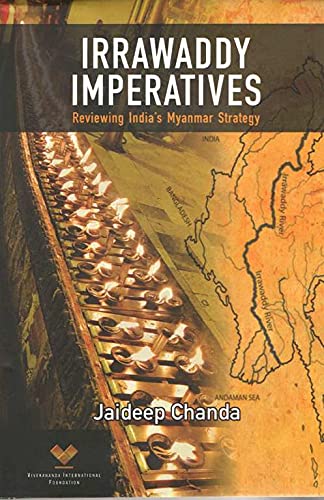India-Myanmar (Burma) relations are rooted in shared history of cultural, religious and trade ties. The Burmese script is based on the Granthi script. Both countries are former British Colonies and attained their independence in the late 1940s after the end of IInd World War. People of Indian origin played a prominent role in Burma’s economy, education and administrative service. Many of them were also in the forefront of Burma’s freedom movement. Post-independence, both countries shared similar internal and external threats and economic challenges. As the then Defence Minister, Shri Krishna Menon said “What hurts Burma, hurts us equally”, reflecting the shared concerns and close relations between the two neighbours. About 500,000 Indian diaspora continue to live in Myanmar.
It is puzzling, therefore, that there is a lack of sufficient interest in our Eastern Neighbour. This benign neglect – what the author, Jaideep Chanda, calls the lack of “Myanmar consciousness” is a blind spot in the study of neighbours and in our strategic thinking. As the author notes, the JNU School of Languages, Literature and Culture Studies covers a wide variety of languages – Portuguese, Spanish, Greek, Turkish, Hebrew, Pushtu and even Mongolian amongst many others, but ignores Burmese. The literature and studies on India- Myanmar relations is scant. Myanmar is not considered as part of South Asia, nor is it a member of SAARC. Perhaps, this has a lot to do with the military takeover of erstwhile Burma in 1962 and its domination of the Myanmar polity since then. The book “Irrawaddy Imperatives” holistically covers India-Myanmar relations and fulfills a long felt need for a scholarly study on the subject.
The book was written prior to the military takeover in Feb 2021. It contains 14 Chapters and covers the entire gamut of issues covering the geography of Myanmar, Indo-Myanmar Boundary issues, historical perspectives of the relations, trade and economy, the Myanmar Army, the pivotal role of Aung San Suu Kyi on the national psyche, international sanctions and the impact of the China-Myanmar Economic Corridor (CMEC), have been analysed at length.
The boundary between India and Myanmar stretches over 1600km and is a legacy of East India Company’s Treaty of Yandboo with the King of Ava of 1826 – a border that divides homes, villages, indigenous tribes and people, giving rise to ethnic insurgences on either side of the border. It is to the credit of both the countries that they agreed to permitted movement of local population and trade on either side of the border upto 40 km (since reduced to 16 km).
India’s relations with Myanmar have been on a roller coaster since the military takeover in the early 60s. The Junta’s repeated attempts at ruthlessly putting down the democratic aspirations of its people has pushed Myanmar into forced isolation and continued international sanctions. India is in an unenviable position. Good relations with Myanmar are vital for containing cross border insurgencies and security. Myanmar is also a conduit and vital link to our Act East Policy. An antagonistic policy towards the Military Junta would only push the country into an already influential and overbearing Chinese fold. Yet India cannot abandon its support to democratic aspirations of the people led by Aung San Suu Kyi and others. In this context, the role played by India’s Defence Diplomacy since early 2000s is praiseworthy. Confidence building measures, followed by mutually acceptable and beneficial solutions to the teething issues of border management including border trade has been facilitated. Formal and informal mechanisms for sharing information on cross border terrorism have been instituted. However, it is obvious that Defence Diplomacy has its limitations.
On the economic front, the author examines the much-heralded Kaladan Project and the Trilateral Road Project, linking India-Myanmar-Thailand. It is a sad commentary that these projects have yet to make any substantial progress.
The chapter on Myanmar Army (Tatmadaw) and its efforts to raise its “Standards” is interesting. Born out of the country’s freedom movement, the Myanmar Army’s role as the self-proclaimed “saviour” and the arbiter of Myanmar’s Nationhood is well documented.The author opines that the Myanmar Army has not been very effective in fighting ethnic insurgencies plaguing the country, including the issue of Rohingyas. Despite its long years of existence, the Army is feudal in outlook and is dominated by the Bamars; it is poorly trained and lacks organizational control and effectiveness. Its efforts in integration of various ethnic communities into the mainstream has yet to succeed. In comparison, the author notes that the Arakan Army is well organized and effective.
The impact of theCMEC and China’s exploitation of Myanmar’s vulnerabilities due to prolonged sanctions is deep rooted, influencing virtually every facet of its economy. While India cannot match Chinese investments dollar to dollar, nevertheless, it is imperative that the long pending projects such as the Kaladan and Trilateral Road Project among others, should be expedited. Further, it would be in India’s interest in the economic development of states/regions on either side of the border through “hearts and minds investments” – investments of small scale but greater numbers which touch the core needs of the common people of the IMB region. Further, improving cross border connectivity as well as air connectivity between Myanmar and the Buddhist circuit in India would have a positive impact on “Myanmar consciousness”. India must promote people to people contact, showcasing its soft power through technical and educational opportunities in our institutions and universities.
Overall, the Book is well researched, analytical and contains several anecdotes of interest. The author has appended a large number of supporting documents such as Agreements, Treaties and detailed geographical descriptions of various regions of Myanmar. It is well annotated with an exhaustive index. The Book is an excellent addition to the scarce scholarship on the subject and is in effect a seminal text which would serve as an “Area Study of Myanmar” for members of Foreign Service, Armed Forces and research scholars.
Reviewed by Lt Gen K Surendra Nath (Retd)





